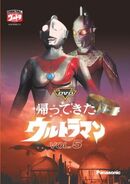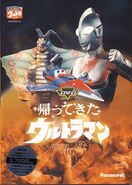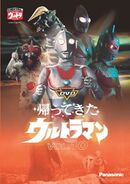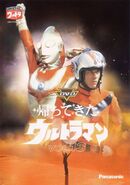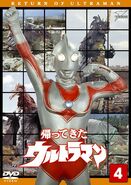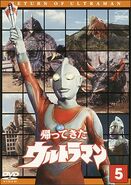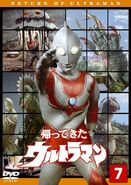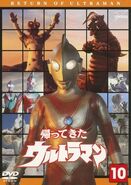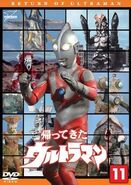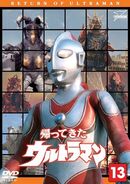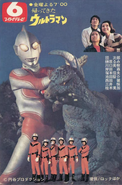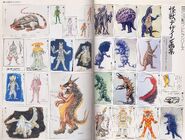Return of Ultraman is a tokusatsu SF/Kaiju/superhero TV series, and is the fourth entry in the Ultraman Series.
The series can be watched on Shout TV, Roku, Tubi, Pluto, and Prime Video.
Production

The "Return of Ultraman" Proposal.[1]
At the beginning of 1969, with Tetsuo Kinjo and Shozo Uehara leaving Tsuburaya Productions, the company faced a significant transition. On January 25 of the same year, Eiji Tsuburaya passed away due to illness, and his eldest son, Hajime Tsuburaya, succeeded him as the second president. Tsuburaya Productions entered a difficult period, experiencing substantial organizational changes. Despite this, the high viewership ratings from the reruns of Ultra Q, Ultraman, and Ultraseven, along with strong sales of related products, provided a new opportunity for the company. Kazuho Mitsuta became the head of the planning department, collaborating with Seiji Shigemitsu Taguchi to develop new shows for the 1970s.[2]
The first proposal written by Taguchi was printed on April 28, 1969, titled Special Effects Monster Series / Continuation of Ultraman . This proposal featured the concept of the original Ultraman returning. The plan was then submitted to Yoji Hashimoto, a producer at the TBS Film Department, who had a deep affection for Ultraman and shared the desire to revive the series with Hajime Tsuburaya. During the review process, Hashimoto set very high standards for the proposal.[2]
This Continuation of Ultraman is set 30 years after the original Ultraman left Earth. Due to natural phenomena and nuclear experiments, monsters began to awaken, and the Self-Defense Forces, lacking experience in dealing with these creatures, struggled when a monster emerged from Mount Fuji. Captain Muramatsu, who had long disbanded the SSSP, appeared among the crowd and fervently hoped for Ultraman's return. At this moment, Ultraman descended from the sky once more, actively engaging on the battlefield, defeating the monster, and then flying away. Following this event, MAT was formed to combat the monster threat.[2]
Subsequently, episodes 2 and 3 detailed the story's progression, including the assembly of the six MAT members, Ultraman's sudden reappearance, and the main character, Hideki Ban , being saved by Shin Hayata. Ultimately, Ban replaces Hayata and merges with Ultraman, becoming the new Ultraman. After some revisions, the proposal was finally titled Returning Ultraman . This title was Eiji Tsuburaya's idea, intuitively conveying the image of Ultraman's re-emergence.[3]
The finalization of the new "Ultraman" project was delayed until the end of 1970. After the time slot prepared by Takeda was canceled between October and November 1970, the series was scheduled to air in the 7 PM Friday slot managed directly by TBS, supported by multiple sponsors. This rescheduling delayed the show's broadcast until 1971.[2]
After revisions, the newly restructured proposal Return of Ultraman was completed in 1970. In this new setting, Ultraman transforms into a young man named Hideki Ban, who works at the Madokura Ranch. Additionally, the characters of a girl named Kaoru, who idolizes Ban, and her younger brother Masayuki were created. In the storyline of this period, Ban secretly joins MAT and battles the monster Astron, but Ultraman is defeated. As a result, Ban vows to master a special finishing move through intense training, adopting the then-popular hot-blooded sports style.[4][5]
Following the confirmation of the project, around the end of 1970 or early 1971, Hashimoto, along with Hajime Tsuburaya and Ken Kumagai, invited Shozo Uehara to participate in the series production. After discussions, Uehara printed the preparatory script for the first episode, "Phoenix Man", on January 13, which was almost identical to the final version. By this time, the show's title had been officially set as Return of Ultraman, and related trademark registrations and other necessary preparations were underway. Subsequently, the writing duties were jointly handled by Hashimoto and Uehara.[4][6]
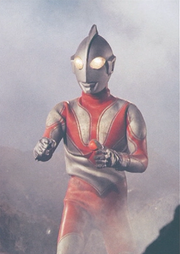
The NG version suit of New Ultraman, which had already been filmed for the first episode, was ultimately redesigned by Akihiko Iguchi following suggestions from the sponsors. Scenes from the first episode were also re-filmed.[7]
Filming for Return of Ultraman commenced on February 6, 1971, under the leadership of Hajime Tsuburaya, Ken Kumagai, and Toho's Susumu Saito. The direction was led by Ishiro Honda, with Toho's Masanori Kakei joining as a scriptwriter from the third episode onwards, and Toei's rising director Noboru Kaji from Nikkatsu specializing in youth-oriented to action-oriented films. The filming for the special effects department was scheduled to start in mid-February.[4]
In the initial proposal, the plan was for the original Ultraman to return, and the body contours remained the same. This design was proposed by Masahiro Matsu, the Operations Manager of Tsuburaya Productions, and the design drawings were completed by Akihiko Iguchi. After the first suit was completed, the special effects battle scenes for the first episode were filmed. However, considering commercial factors, based on feedback from the licensing partner Bullmark, it was necessary to clearly distinguish this character from the original Ultraman. This led to a redesign to avoid too much similarity with the original Ultraman.[2]
These modifications included changes to the contours of the neck and the design of the two thighs, as well as adding gloves, boots, and fine stripes around the red area for Ultraman. This new character was subsequently referred to by fans as "New Ultraman," a name that Tsuburaya Productions also used in later series.[6]
The first season of the series was shot at Toho Studios, with the MAT command room set up in Studio 101, and the special effects scenes in Studio 2. From the second season onwards, filming was shifted to Tokyo Film Studios, and special effects were done in two studios at the Tokyo Art Center. During this period, writers such as Shigemitsu Taguchi, Shinichi Ichikawa, and Toshiro Ishido were involved in the series, while directors also expanded the production team by adding Eizo Yamagiwa from International Pictures.[4]
In the production of the show, compared to the "near-future" and "high-tech" atmosphere created in the previous two works, the series adopted a more realistic portrayal of early 1970s Japan. It also focused more on the serious drama of Hideki Go's struggles and growth. However, as a sequel to the popular series Ultraman, TBS had high expectations for its viewership ratings. Nevertheless, the initial ratings did not meet expectations. This was partly due to the serious TV drama elements not being fully embraced by children, and also because budget constraints limited the destruction scenes primarily to rural areas, lacking the exhilaration of urban destruction. This made it difficult for the ratings to exceed 20% after the episode 6.[6]

In the third quarter of the series, four episodes aired in November were dubbed by fans as the "November Masterpieces" due to their exceptional narrative. However, this name sparked controversy as it diverted attention from the rest of the series.[8][9][10][11]
Upon observing this situation, Tsuburaya Productions immediately initiated surveys and market research through interviews published in serialized magazines related to Ultraman. The findings indicated a desire among viewers to strengthen Ultraman and increase the presence of space monsters. With the implementation of enhancements such as upgrades to MAT, the introduction of new abilities like the Ultra Bracelet, and the inclusion of space monsters, the show became more enriching. By the episode 23, the ratings began to soar rapidly, with almost all episodes of the third season achieving around a 25% viewership rating. The production budget, initially constrained due to reflections on the past, gradually increased, reaching a scale where each episode consumed an average of 5.5 million yen.[6]
During the filming of the third season, scheduling Rumi Sakakibara, who played the female lead Aki Sakata, became increasingly challenging due to her involvement in other television dramas. As a result, in episodes 37 and 38, it was decided to have both Ken Sakata and Aki disappear from the storyline after being killed by Alien Nackle.[12][13] However, cameo appearances of the original Ultraman and Ultraseven, along with their human hosts, were added, leading to peak ratings at that time.[6]
In terms of the TV series, the focus on Go's personal life shifted to the Sakata family's sole surviving member, Jiro, and their neighbor Rumiko Murano. In the special effects part, measures were taken to strengthen the entertainment value by increasing the number of appearances of monsters and their alien controllers simultaneously. After the final episode aired, the curtain fell as Go departed Earth as Ultraman. However, this marked the beginning of the continued development of the Ultraman series in the second stage of the Showa era.[4][14]
Synopsis
In a fight between two giant monsters named Takkong and Zazahn, young race car driver Hideki Go is killed while trying to rescue a little boy and a dog from the falling rubble. His valiant sacrifice is noted by everyone, even his friends and the new defense force MAT, but an unseen being also takes notice. Looking over Go is the "New Ultraman", who is so touched by Go's actions that he decides to combine his life force with that of Hideki, thus bringing him back to life. Hideki Go then joins MAT and fights alongside them and Ultraman against monsters and alien invaders.
Characters
MAT
Others
Ultras
Kaiju
- Takkong
- Zazahn
- Arstron
- Sadola
- Detton
- Kingsaurus III
- Gudon
- Twin Tail
- Gorbagos
- Ghostron
- Dangar
- Stegon
- Mognezun
- Shugaron
- Seamons
- Seagorath
- Eledortus
- Terochilus
- Bemstar
- Sartan
- Magnedon
- Beacon
- Gokinezura
- Zanika
- Vacuumon
- Kupukupu/Kingstron
- Zagoras
- Nokogilin
- Gronken
- Varricane
- Yadokarin
- Oxter
- Plooma
- Alien Zelan
- King Maimai
- Alien Mates
- Muruchi
- Leogon
- Pris-Ma
- Draculas/Vampire Woman
- Black King
- Alien Nackle
- Alien Varduck
- Alien Black
- Snowgon
- Alien Baltan Jr.
- Builgamo
- Alien Stora
- Paragon
- Alien Grotes
- Kodaigon
- Granadas
- Alien Centaurus
- Robonez
- Alien Cygnus-61 Erika
- Alien Messie
- Alien Zoole
- Red Killer
- Femigon
- Yametaranese
- Sasahiller
- Alien Mysteler
- King Bockle
- Alien Bat
- Zetton II
Cast
- Hideki Go : Jiro Dan
- Katsuichiro Kato : Nobuo Tsukamoto
- Ryu Ibuki : Jun Negami
- Takeshi Minami : Shunsuke Ikeda
- Ippei Ueno : Ko Mitsui
- Yuriko Oka : Mika Katsuragi
- Fumio Kishida : Ken Nishida
- Jiro Sakata : Hideki Kawaguchi
- Aki Sakata : Rumi Sakakibara
- Ken Sakata : Shin Kishida
- Rumiko Murano : Kazuko Iwasaki
- Ultraman Jack : Isao Yatsu
- Narrator : Akira Nagoya
Suit Actors
- Ultraman & Zazahn : Eiichi Kikuchi
- Kaiju : Takanobu Toya (Most of the Monsters)
Music
- Opening Theme
- Kaettekita Ultraman
- Lyrics: Kyōichi Azuma
- Composition: Koichi Sugiyama
- Artist: Jiro Dan, Misuzu Children's Choral Group
Home Media
In 2002, Tsuburaya began re-releasing Ultraman to Ultraman Leo on Japanese boxsets. Return of Ultraman got a boxset. There is also a DVD release made by the Malaysian company VGB Network. It came out in 2013, and contains Malay, English, and Chinese subtitles. A few grammatical errors were made, as VBG is not a American company.
Mill Creek released the series to Blu-ray on February 25, 2020 with English subtitles. As with the company's other Showa-era Ultraman Series titles, a SteelBook and a standard edition with part of a spine mural were offered.
Movies
- Return of Ultraman (film) (movie version of episodes 5-6)
- Return of Ultraman: Fear of the Tornado Monsters (movie version of episodes 13-14)
- Jiro-Kun Rides a Monster (movie version of episode 29)
Manga
- Main article: Return of Ultraman (manga)
A manga series by Akira Mizuho ran in Bessatsu Shōnen Sunday from May to December 1971.
Gallery
Trivia
- Originally, Ultraman Jack was meant to be Ultraman, who would have returned to Earth as referenced by the show's name, Return of Ultraman, but this decision was scrapped and he was made into a separate character out of respect to the late Eiji Tsuburaya, who passed away in 1970. However, the name of the show still remained "Return of Ultraman".
- In the original concept for Return of Ultraman, Hideki Go was meant to use the Beta Capsule to become Ultraman Jack, like how Shin Hayata transformed into Ultraman, but this decision was also scrapped.
- Return of Ultraman is the first series to contain an advertisement break featuring the logo.
- In 2014, Hideaki Anno proposed a Return of Ultraman film to Tsuburaya Productions.
- Among the Showa era Ultraman Series, Return of Ultraman is the only one not to be streamed at Tsuburaya Productions' YouTube channel during its 50th anniversary in 2021.
External Links
- Return of Ultraman at Tsuburaya Productions' official website
- Return of Ultraman at Wikipedia
- Return of Ultraman at Japanese Wikipedia
References
- ↑ https://k.mandarake.co.jp/auction/item/itemInfoJa.html?index=658004
- ↑ 2.0 2.1 2.2 2.3 2.4 Ultra Tokusatsu PERFECT MOOK vol. 4: Return of Ultraman, pg 4
- ↑ https://x.com/kimonuruwota/status/1363091650520752136
- ↑ 4.0 4.1 4.2 4.3 4.4 Ultra Tokusatsu PERFECT MOOK vol. 4: Return of Ultraman, pg 5
- ↑ https://magmix.jp/post/16331
- ↑ 6.0 6.1 6.2 6.3 6.4 https://magmix.jp/post/180738
- ↑ https://ameblo.jp/addicto/entry-12114669855.html
- ↑ https://magmix.jp/post/66471
- ↑ http://h-yamato.cocolog-nifty.com/ultraqg/2009/07/11-5f37.html
- ↑ https://x.com/aitahide/status/1732774854125113525/
- ↑ https://x.com/KanedaMasumi/status/1457340648881672199
- ↑ https://magmix.jp/post/116102/2
- ↑ https://magmix.jp/post/16331/2
- ↑ https://www.sanspo.com/article/20230301-SFFICOO7BNPXDGW2PDCG63KCKQ/





